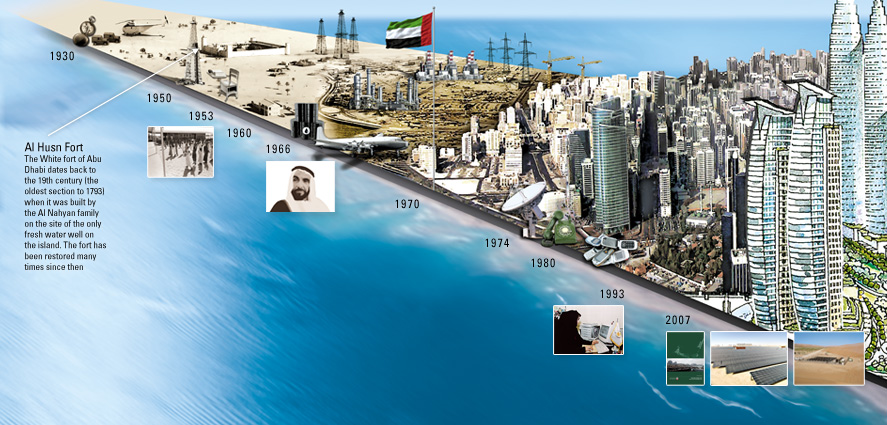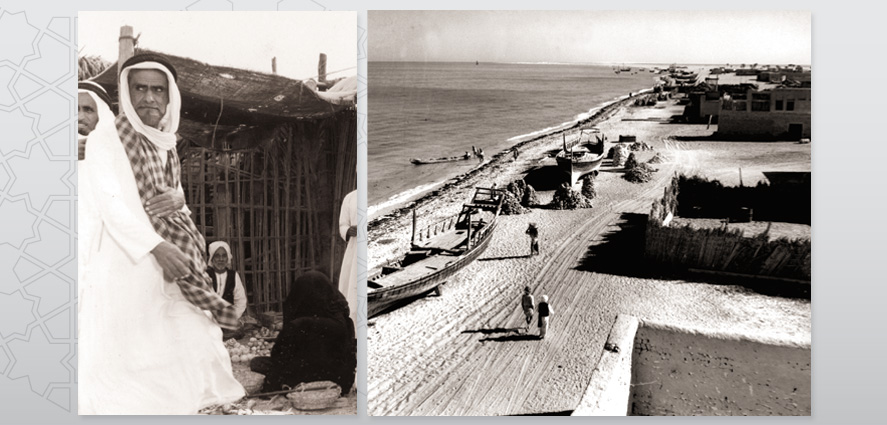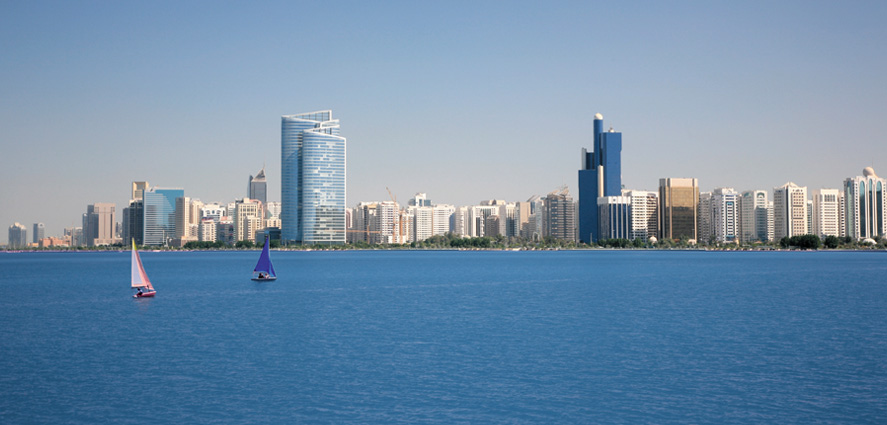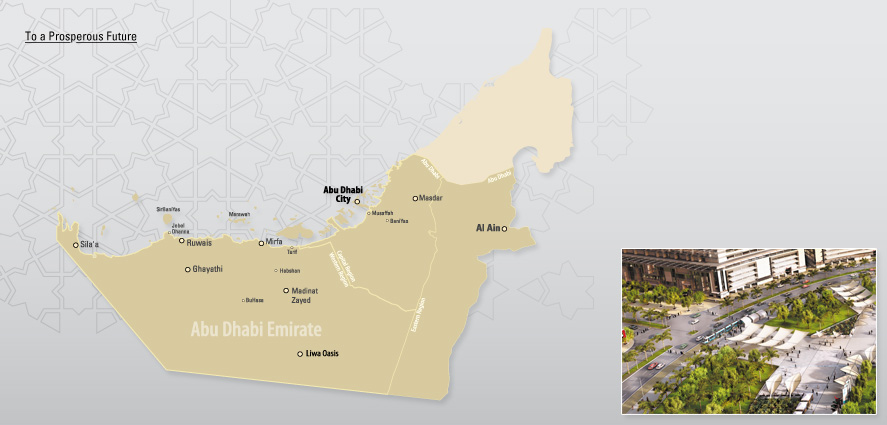
Sprint Towards Modernity

Sprint Towards Modernity

Before the emergence of the oil-based economy in the early 1960s, traditional local culture had two main components: the nomadic desert-oriented Bedouin with small oasis farms and those involved in the sea-oriented lifestyle that revolved around pearling, fishing and maritime trade. These subcultures were economically, politically and socially interdependent, weaving into a common culture and social fabric.
When the Late Sheikh Zayed bin Sultan Al Nahyan became ruler in 1966, he inherited an impoverished Emirate in the desert virtually without any schools, hospitals or infrastructure. Within three decades, his government led the transformation of Abu Dhabi, and the rest of the UAE, into a modern state with infrastructure that has attracted plaudits internationally, placing the country firmly on the global map.
Where palm-frond huts once sat on the sand, skyscrapers now dominate Abu Dhabi's skyline. Few other places in the world have experienced a comparable amount and rate of urbanisation – certainly few have done it so successfully. Abu Dhabi's rapid development, a product of inspired leadership, has managed to avoid the many pitfalls common to rapid urbanisation, such as shanty towns, smog, power shortages or gridlock. Its sprint towards modernity is a truly remarkable achievement.
Sprint Towards Modernity

Before the emergence of the oil-based economy in the early 1960s, traditional local culture had two main components:
the nomadic desert-oriented Bedouin with small oasis farms and those involved in the sea-oriented lifestyle that revolved around pearling, fishing and maritime trade. These subcultures were economically, politically and socially interdependent, weaving into a common culture and social fabric.
When the Late Sheikh Zayed bin Sultan Al Nahyan became ruler in 1966, he inherited an impoverished Emirate in the desert virtually without any schools, hospitals or infrastructure. Within three decades, his government led the transformation of Abu Dhabi, and the rest of the UAE, into a modern state with infrastructure that has attracted plaudits internationally, placing the country firmly on the global map.
Where palm-frond huts once sat on the sand, skyscrapers now dominate Abu Dhabi's skyline. Few other places in the world have experienced a comparable amount and rate of urbanisation – certainly few have done it so successfully. Abu Dhabi's rapid development, a product of inspired leadership, has managed to avoid the many pitfalls common to rapid urbanisation, such as shanty towns, smog, power shortages or gridlock. Its sprint towards modernity is a truly remarkable achievement.
From a Subsistence Past

The Emirate is primarily a vast desert with well over 100 islands in the coastal waters, including the island where the city of Abu Dhabi is located. Traditionally, the population along the coast relied on fishing and pearling for their livelihood, whilst those in the hinterland subsisted on date plantations and camel herding.
Before the mid-1960s, Abu Dhabi town was a group of clusters of modest dwellings lacking basic services such as electricity and potable water. Sandy tracks linked groups of houses built of 'arish (palm fronds), scattered along a coastline where the capricious interface of desert and sea offered only a marginal existence for the few thousand resilient inhabitants.
Nothing was easy. Water was collected from hand-dug wells. Food was cooked over wood fires. There were no formal schools, clinics or hospitals. Basic modern services were distant dreams for these early Abu Dhabi residents.
Male citizens wore the traditional dress of a white robe (kandoura) and white headcloth (ghutrah) with a black rope (aqal). Conversely, Emirati women wore loose, colourful clothing often with a piece of cloth held or draped over their head. Many often wore a traditional face mask (burqa). Most Emiratis still wear the same clothes today.
To an Urban Present

However impossible past dreams of modernity may have seemed, many have now become a reality. 21st century Abu Dhabi continues to grow and evolve, defining pathways towards the future with a metropolis of regional and global influence. The transformation has been extraordinary, from local subsistence to global influence within little more than a single generation.
For the visitor to Abu Dhabi, a drive along the Eastern Corniche or ‘Al Qurm' offers a memorable experience. This palm-fringed boulevard meanders along a coast of villas, mangroves and lagoons into the heart of the modern city. By day or night, the surrounding cityscape is awe inspiring. Residential buildings and office towers interspersed with ever-rising skyscrapers compete in grandeur and innovative design. Much of the land on which they stand has been laboriously reclaimed from the sea.
This process continues as new islands are sculpted and reconfigure the coastal and urban geography. Once endowed with road networks, stylish buildings and modern infrastructure, they will become the latest additions to a rapidly evolving urban–human landscape. The rapid growth of Abu Dhabi is continually redefining the dynamic process of urbanisation.
From a historical perspective, this process has occurred with lightning speed. Abu Dhabi has modernised over mere decades, an evolution that for other major cities worldwide required centuries if not millennia of fluctuating fortunes with triumphs and tragedies. The Emirate has leapfrogged traditional agricultural and industrial revolutions into a modern, progressive society and the change continues apace.
To a Prosperous Future

Master plans for different areas of the Emirate lay the groundwork for even more astonishing developments into 2030 and beyond. The Western Region (Al Gharbia), for example, has until now had relatively few residents, many being workers in the oil and gas industries. New plans could lead to a major expansion of the population, with an extensive transportation system and state of the art infrastructure. Mirfa could become an important hub with more than 100,000 inhabitants. Ruwais, Sila'a, Ghayathi and Madinat Zayed all also have plans for substantial growth. In addition, the Emirate's government has a particularly focused expansion agenda for Liwa Oasis, the traditional home of the founders of Abu Dhabi.
Similar plans are being drawn up for Al Ain, which is known as the ‘Oasis City.' These plans aim to conserve its unique natural setting as a city between the mountains and the desert and to celebrate both its cultural heritage and its history of sustainable development.
Unique aspects of the Emirate's environment have been described in this Atlas including the biodiversity, physical landscape, climate, natural resources and culture. This chapter focuses on pathways of development for Abu Dhabi – past, present and future – including major achievements, lessons learnt, forthcoming challenges and the search for solutions.

















